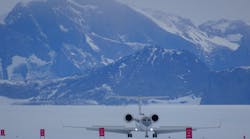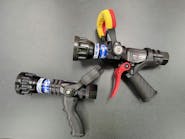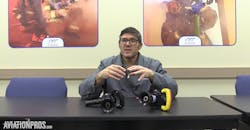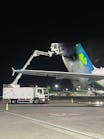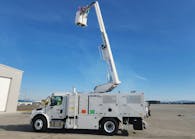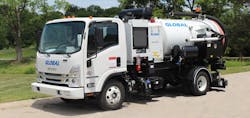Winter weather conditions impact aviation throughout the winter season. But if planes are scheduled to fly, ground support personnel must be ready to work regardless of condition.
As frigid temperatures and windy conditions reach extreme levels, it is important those working outdoors avoid cold stress.
“At the end of the day, if the airport is still open, we have to provide the service because we’re contractually obligated to do so. At WFS, safety is a top priority, so we’ll take whatever precautions are necessary to ensure the safety and well-being of employees and customer aircraft,” says Victor Chin, senior vice president, safety and security compliance for the Americas at Worldwide Flight Services (WFS).
According to the Occupational Safety and Health Administration (OSHA), cold stress and its effects can vary depending on location. Simply put, cold stress occurs by driving down the skin temperature and eventually the internal body temperature.
“When the body is unable to warm itself, serious cold-related illnesses and injuries may occur, and permanent tissue damage and death may result,” warn OSHA officials, noting frostbite and hypothermia are types of cold stress.
As heat leaves the body, workers can become vulnerable to cold stress. What’s more, increased wind speed causes heat to leave the body more rapidly. Being wet or damp, even from body sweat, further facilitates heat loss, OSHA officials say.
Being aware of the wind chill temperature is critical, so employers can determine the exposure risk of their workers.
OSHA also recommends monitoring workers’ physical condition while performing tasks. This is especially true for new workers who may not be accustomed to cold working conditions and for those employees that have returned to the job after spending time away from work.
“Environmental cold can affect any worker exposed to cold air temperatures and puts workers at risk of cold stress,” officials at OSHA say. “As wind speed increases, it causes the cold air temperature to feel even colder, increasing the risk of cold stress to exposed workers, especially those working outdoors.”
With this in mind, it’s important for employers to protect workers from the hazards of working in frigid conditions. OSHA recommends employers train workers and provide engineering controls, insist the proper protective clothing is utilized and implement additional best practices.
Training
What is considered “cold weather” may vary from location to location, but WFS’ Chin says once temperatures drop below freezing levels, general managers (GMs) are instructed to take additional precautions with their crews.
“The alert process usually goes through the GMs, and the GMs disseminate the information by posting the safety bulletins. We also provide them with content for their shift briefings,” Chin explains. “The GMs will then push that down to their employees during their shift briefings to ensure it’s front and center.”
Officials at Menzies Aviation, which provides deicing services to airlines in some of the world’s most extreme environments, note using the latest equipment correctly and safely is paramount to working in the cold.
“Sufficient training is our No. 1 priority when it comes to looking after the safety of our employees,” says Stuart Carmichael, SVP of risk for Europe, Middle East and Africa (EMEA), adding in Scandinavia alone, his company has already performed more than 5,000 deicing operations during the 2018/19 winter season using Vestergaard Elephant Beta deicers.
“Menzies delivers the highest level of safety and technical training to our deicing teams,” he continues. “All of our new deicers are required to undertake a combination of classroom, on the job, online and simulator (on demand) training. Each year, this training is refreshed, and employees must complete a further examination in line with our company requirements, based on AS6285A and AS6286 and in line with local regulations.”
Similarly, Shaun Hannam, head of safety at dnata, says campaigns are run regularly at relevant stations to ensure colleagues are adequately prepared for bitter conditions.
He says dnata makes sure employees are aware of the importance of wearing the correct cold weather personal protective equipment (PPE); regularly take warm breaks indoors; understand the importance of continued hydration with hot liquids; and recognize the signs and symptoms of cold-induced illness and how to deal with it.
In addition to comprehensive training, OSHA recommends employers provide engineering controls, which can be effective in reducing the risk of cold stress.
“For example, radiant heaters may be used to warm workplaces like outdoor security stations. If possible, employers should shield work areas from drafts or wind to reduce wind chill,” OSHA officials say. “Employers should use engineering controls to protect workers from other winter weather related hazards.”
WFS’ Chin notes once temperatures fall below 32 degrees F, his company issues specific safety bulletins to remind employees to avoid trips and falls.
These announcements advise employees to plan extra time when doing work, so they’re not in a rush. Additionally, the bulletins serve as reminders to remove snow from the bottom of shoes when entering a building, use handrails, stay on designated walkways and other safety measures.
Team leaders should use salt and sand when and where possible to keep walking surfaces clear of snow and ice to prevent trips. And if driving a vehicle, stopping distances should increase
PPE
In addition to proper footwear, OSHA officials point out that dressing properly is vital to preventing cold stress.
Layering provides better insulation, and because of this OSHA officials suggest wearing at least three layers of clothing, focusing on keeping moisture away from the body. What’s more, a mask to cover the face and mouth, a hat to cover ears and reduce the amount of body heat escaping from the top of the head, insulated gloves to protect hands and waterproof boots to protect the feet can allow safer working practices.
“We ensure that our employees are equipped with the very latest PPE,” says Menzies’ Carmichael. “At a minimum, this includes goggles, heavy duty rain jackets (wind proof), ear defenders, caps, safety boots and safety harnesses (where needed) to protect them from the very cold and harsh weather conditions.”
Also, hand warmers can be inserted into gloves to add addition heat and cold-weather protection.
Best Practices
A critical component of working outdoors is staying in communication with all parties involved and being prepared.
“Our Winter Readiness program involves thorough preparation for all aspects of cold weather requirements, including supply chain management, vehicle preparation, documentation and procedure checks, engagement with airline customers and pre-auditing and inspection of facilities and providers,” Menzies’ Carmichael states. “We engage in detailed planning in advance of the winter months and conduct weekly deicing calls throughout the season to ensure active oversight of the entire operation.
“In addition, we host an annual deicing conference for our EMEA, Oceania and Americas regions,” he notes. “We invite our airline customers, accountable managers, DAQCP, fluid and deicer manufacturers to gather and discuss the latest innovation, policy and technology developments to ensure that we are at the forefront of the industry.”
“We’ll remind GMs and advise them to provide hot chocolate or instant soups for the employees,” Chin of WFS adds. “We’ll remind employees to go inside every so often to warm up. Because once you’re out there in the elements, you’re working a flight, it’s easy to get distracted and forget how long you’ve been out there. So, we’re proactively reminding and encouraging employees to go back inside and warm up.”
If conditions are becoming more treacherous, dnata’s Hannam says employees should voice their concerns.
“We take many steps to ensure work is completed without putting people at risk,” Hannam says. “We encourage our employees to raise any workplace safety issues with their supervisors through our observation program. This can be cold weather issues or any other hazards.
“Briefings are conducted prior to high-risk activities to ensure colleagues understand risks and hazards,” he continues. “Specifically, for cold weather the teams are briefed to ensure adequate rest times are clear, appropriate PPE is available and cold-induced illness signs and symptoms are understood.”
In summary, to determine if safe work practices are in place, OSHA says to consider:
- Providing workers with the proper tools and equipment to do their jobs.
- Developing work plans that identify potential hazards and the safety measures that will be used to protect workers.
- Scheduling maintenance and repair jobs for warmer months.
- Scheduling jobs that expose workers to the cold weather in the warmer part of the day.
- Avoiding exposure to extremely cold temperatures when possible.
- Using relief workers to assign extra workers for long, demanding jobs.
- Providing warm areas for use during break periods.
- Providing warm liquids (no alcohol) to workers.
- Monitoring workers who are at risk of cold stress.
- Monitoring the weather conditions during a winter storm, having a reliable means of communicating with workers and being able to stop work or evacuate when necessary.
- Acclimatizing new workers and those returning after time away from work by gradually increasing their workload, and allowing more frequent breaks in warm areas, as they build up a tolerance for working in the cold environment.
- Having a means of communicating with workers, especially in remote areas.
- Knowing how the community warns the public about severe weather.
“We’ve been operating for many years, not just in the U.S. but globally,” Chin says. “We have experience operating in many different types of climates and environments, and different types of winters and weather conditions.
“Our operational leaders will hold regular calls with their teams, so we’re sharing best practices. Our safety team also holds regular calls with all of our GMs where we also share best practices and lessons learned,” he continues. “So, we’re not going to wait for something to happen before we send out a reminder to an individual station.”


